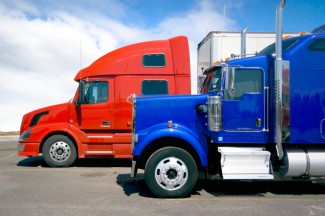The first-ever Run on Less roadshow demonstrated just how fuel-efficient a tractor-trailer can be in real-world operation. Seven Class 8 Freightliner, International, and Volvo tractor trucks drove 50,000 miles across the country, carrying more than 55,000 lbs. of goods on average, and converged in Atlanta on Sunday for the grand finale. While roadshow organizers North American Council for Freight Efficiency (NACFE) and Carbon War Room were aiming for 9 miles per gallon, the trucks averaged more than 10 miles per gallon — in real-world operation and in real weather, including encounters with Hurricanes Harvey and Irma.
Some major takeaways from the event:
Tractor trucks can achieve high fuel efficiency using today’s commercially available technologies. All seven participating trucks achieved more than 10 miles per gallon during the roadshow, and two trucks topped 11 miles per gallon. These trucks were equipped with 2014-2018 model year engines, automated manual transmissions, and 53-foot trailers with skirts and trailer tails (except one truck). No doubt, the participation of some of the best drivers in the profession — NACFE Executive Director Mike Roeth dubbed them “the Jack Nicklauses of trucking” — bumped up the miles per gallon substantially. Nevertheless, today’s emerging truck technologies can help all drivers approach the results of the masters.
Run on Less validates Environmental Protection Agency and Department of Transportation’s Phase 2 standards for tractor trucks. National standards adopted in 2016 would improve average new tractor-trailer certified fuel economy to 8.2 miles per gallon in 2027 from the present level of 6 miles per gallon, assuming current efforts to undermine the standards are unsuccessful. Run on Less trucks handily beat the 2027 target with today’s commercially available technologies. While roadshow trucks were not operated in the precise conditions specified in the standards, exceeding 2027 fuel economy levels in on-road driving is a highly significant achievement. In fact, Run on Less trucks approached the 12 miles per gallon efficiencies demonstrated in DOE’s SuperTruck program with the help of technologies not yet commercialized.
Truckers can save big at the pump. Many tractor-trailers drive 120,000-150,000 miles annually and can be on the road for 10 years or more. Consequently, a one-mile-per-gallon increase can provide big bucks for their owners/fleets. Run on Less trucks achieved an average fuel economy that is 66% higher than the national average for new trucks. With this level of improvement, a new tractor truck could save almost double the $150,000 purchase cost in its lifetime.
Integration of engine, tractor, and trailer is key. The high fuel efficiency achieved by the roadshow participants came from the combination of engine, transmission, aerodynamic and tire technologies, and their integration. Aerodynamic drag, the biggest factor in fuel consumption for tractor trucks at highway speeds, was reduced by the addition of skirts, tails, and gap reducers (figure 1) and optimal pairings of tractor and trailer. Trailers contributed substantially to achieving these double-digit fuel economy values, confirming that EPA and DOT got it right when they brought trailers under the Phase 2 standards.
Run on Less showcased very high fuel efficiency under realistic loading profiles and road grades, using expert drivers and some of today’s best technology. Trucking fleets will be inspired to explore these and other new technologies, adopt the best practices of these drivers, and set new fuel economy targets for their operations. The grand success of Run on Less demonstrates that fleets investing in fuel-efficiency technologies will save a lot of fuel — and money.
[1] https://www.epa.gov/verified-diesel-tech/smartway-designated-tractors-and-trailers



